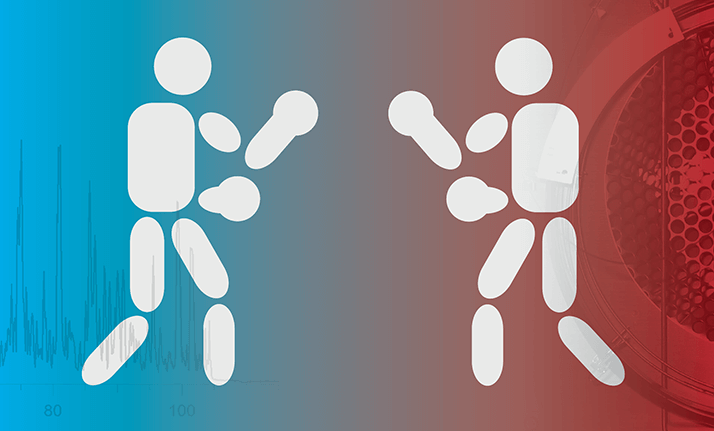

What happens to small molecules during GC-MS analysis? Gary Siuzdak, professor and senior director of TSRI’s Scripps Center for Metabolomics, Mingliang Fang, a postdoc and GC-MS specialist at Scripps, and other members of the lab’s team have interrogated the data being generated by GC-MS by mimicking its conditions and performing LC-MS analysis to investigate the fate of molecules in the sample. The results were analyzed on the XCMS data analysis platform developed in house. They reported some cause for concern – the temperature involved in GC-MS can result in half the metabolites being degraded or transformed. We caught up with Siuzdak to find out why his study is generating quite a lot of its own heat.
What inspired you to take a closer look at the effect of heating in GC-MS?
Numerous previous studies have examined the effect of heat on specific types of molecules, so we simply applied a global LC-MS based approach to the issue to examine the extent of the effect. Interestingly, thousands of standards have been analyzed by GC-MS, and the observation that a signal was obtained was used as proof of the technology’s robustness. The problem with this is that GC-MS is being used to critically examine GC-MS. Instead, we used LC-MS to investigate GC-MS.Could you give a brief overview of the study and the results you found?
The samples, both derivatized and underivatized, were heated at three different temperatures (60, 100, and 250°C) at different exposure times (30, 60, and 300 s). It is worth noting that we were careful to design the experiments to minimize effects that would not occur in GC-MS. Samples were prepared using a standard protocol, dried, heated under nitrogen, stored at -20°C, placed in solution at neutral pH to minimize hydrolysis, and analyzed by LC-MS at ambient temperatures using soft ESI-MS. We then exploited new informatic capabilities within our data analysis platform (XCMS/METLIN) to allow for global examination of these data sets. XCMS (XCMSOnline.scripps.edu) is a free cloud-based data analysis program that we used alongside another free resource – the METLIN database (METLIN.scripps.edu). Both were developed in house to fill an unmet need for comparative pairwise and multigroup data analysis. METLIN is currently the largest tandem MS database in the world and XCMS currently has over 8500 registered users. Together, XCMS and METLIN allowed us to statistically examine the data output and identify the transformed molecules.The results showed that heating had an appreciable effect on both the underivatized and derivatized molecules, with as much as 50 percent of the metabolites being degraded or transformed. A challenge that we weren’t quite prepared for was how derivatization efficiency dramatically varies from molecule to molecule – anywhere from 10–90 percent. That was documented in the paper but has also been well documented in other studies (referenced in our paper). Ultimately, when you do GC-MS experiments you are performing them on a complex mixture of underivatized, partially-derivatized, and fully-derivatized molecules. These effects can add to the already increasing variance of the system.
Can you share specific examples?
Beyond the extent of degradation, one surprising result was data that was sent to me from a colleague. In developing an amino acid assay with GC-MS they observed an apparent transformation product. The derivatized form of arginine was injected into the GC-MS and the identified molecule was ornithine; we did some follow up work and there were already examples of this transformation in the literature.How has the community reacted?
I wasn’t sure what to expect but generally the response has been overwhelmingly positive. Most people were not surprised by the results but appreciated the examination of the thermal degradation process using an orthogonal technology (LC-MS). I also received multiple reminders that, beyond the papers we cited in our Analytical Chemistry paper, other more directed research has been published on thermal degradation, especially in the environmental field. It is now clear from these correspondences that even more research has been ongoing in other labs on this topic but have gone largely unpublished. One person told me that they were forbidden from doing the LC-MS experiments we performed as the group leader “was afraid of what they would find.” Some individuals however have not been so open to the thermal degradation results, believing that the elevated GC-MS temperatures are not that detrimental to molecular stability. I hope this study at least encourages students to think more critically about their results and to use standards for validation whenever possible. Ultimately, I think from a global perspective the point has been made, as it is hard to argue with the reality that some small molecules thermally degrade at high temperatures. Please let us know what you think by commenting below...References
- M Fang et al., “Thermal degradation of small molecules: a global metabolomic investigation”, Anal Chem, 87(21),10935-41 (2015). PMID: 26434689




